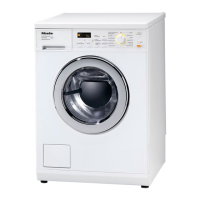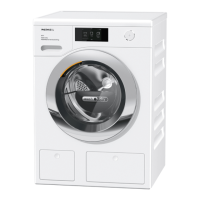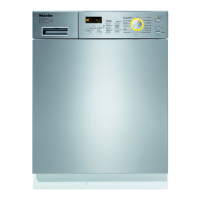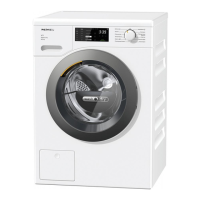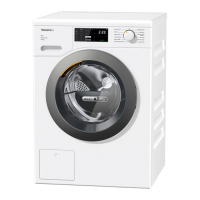
 Loading...
Loading...
Do you have a question about the Miele WTD 160 and is the answer not in the manual?
| Brand | Miele |
|---|---|
| Model | WTD 160 |
| Category | Washer/Dryer |
| Language | English |
Instructions for disposing of packaging materials, emphasizing recycling and environmental friendliness.
Guidance on environmentally responsible disposal of old appliances, including local recycling options.
Defines the intended use of the washer-dryer in domestic households and specific applications.
Safety measures and guidelines for children around the appliance.
Crucial safety information regarding electrical and installation aspects.
Details on safe electrical connections, grounding, and avoiding hazards.
Important operational guidelines to prevent damage and ensure safe usage.
Precautions to prevent fire, particularly regarding textiles and cleaning agents.
Lists specific textiles unsuitable for tumble drying due to fire or damage risks.
Safety advice on using detergents, avoiding hazardous chemicals, and contact precautions.
Overview and explanation of the washer-dryer's control panel and its functions.
Explanation of how sensor controls react and indicate selection status.
Details on the different ways the washer-dryer can be used for washing and drying.
Instructions for removing protective films and stickers before initial use.
Step-by-step guide to removing the drain hose elbow stored in the drum.
Overview of Miele@home system and using the Miele@mobile app.
Instructions for performing the initial wash cycle without laundry.
Procedure for unlocking and opening the door after the initial programme.
Tips and strategies for minimizing energy and water usage during operation.
Recommendations for optimal detergent usage to reduce environmental impact.
Advice on saving energy during tumble drying processes.
Steps for preparing laundry, including emptying pockets and sorting.
Guidance on sorting laundry by colour, care label, and fabric type.
Methods for treating stains before washing to ensure better results.
Additional advice for preparing laundry, such as securing zips and fasteners.
Instructions on how to properly load the drum with laundry for washing.
Guide to choosing the appropriate washing program for different fabric types.
How to adjust temperature and spin speed for optimal wash results.
Options to customize washing programs for better performance.
How to set a delayed start time for wash programs.
Detailed instructions on adding detergent to the dispenser drawer.
How to add fabric conditioner or liquid starch to the correct compartment.
Advice on adjusting detergent dosage based on load and soiling.
Correct method for adding detergent tablets or pods to the drum.
Overview of the CapDosing system and inserting capsules.
How to initiate a wash program by touching the sensor control.
Procedure for unloading laundry after the wash program finishes.
Information on available spin speeds and their effects on programs.
How to skip the final spin cycle to reduce creasing.
Table detailing washing programs, their uses, and maximum load capacities.
Overview of the steps involved in each washing program.
Comprehensive info on detergent, water hardness, and softeners.
Warnings and advice regarding color run removers and dyes.
Steps for preparing laundry for drying, including checking care labels.
Guidance on sorting laundry by fibre, weave, and moisture content for drying.
Advice on drying various fabric types and preventing issues like shrinkage.
Instructions on how to load the drum with laundry for effective drying.
Guide to choosing the right drying program.
How to adjust drying levels, spin speeds, and other settings.
Adjusting the desired residual moisture level for drying.
Changing the preset thermospin spin speed for drying programs.
Options to customize drying programs, like low temperature.
How to set a delayed start time for drying programs.
How to initiate a drying program.
Procedure for unloading laundry after the drying program finishes.
Table detailing drying programs, their uses, and maximum load capacities.
Instructions for combined wash and dry cycles.
Steps for preparing laundry for combined wash and dry cycles.
How to load the drum for combined wash and dry cycles.
Guide to selecting combined wash and dry programs.
Adjusting settings for combined wash and dry cycles.
Instructions for adding detergent for combined wash and dry cycles.
Procedures for starting and ending combined wash and dry cycles.
Steps to take after completing any wash or dry program.
Instructions for using the Rinse out fluff program to remove lint.
How to modify a running program, with safety lock considerations.
Steps to interrupt or cancel a running wash or drying program.
How to safely remove laundry after cancelling a program.
Steps to select and start a new program after cancelling.
Instructions on how to add or remove laundry during a program.
How to set a delayed start time for wash or drying programs.
Step-by-step guide to setting the desired delay start time.
How to activate the delay start function.
Procedures for modifying or cancelling a set delay start.
Information on using SmartStart for automatic program start based on external signals.
How to define the time period for SmartStart activation.
Instructions for cleaning the exterior surfaces and control elements.
Steps for cleaning the detergent drawer and its housing.
How to clean the siphon and channels in the detergent drawer.
How to clean the porthole glass, drum, and water intake filter.
Guide to checking and cleaning the water intake filter.
Troubleshooting steps for when the washer-dryer fails to start.
Diagnosing issues indicated by fault lights and cancellation messages.
Explains fault indicators appearing after a program finishes.
Solutions for common issues like display dark, noises, and smells.
Troubleshooting tips for common washing result issues like residues or poor cleaning.
Solutions for problems related to damp or overly dry laundry after drying cycles.
Steps to resolve issues where the door remains locked or won't unlock.
Emergency procedures for opening the door during specific fault conditions.
Instructions for cleaning the drain filter and checking impellers.
Information on how to contact Miele customer service for assistance.
Details regarding the appliance's warranty period and activation.
Information on available optional accessories for the washer-dryer.
Accessing product data and energy labelling via the EPREL database.
Explanation of symbols related to washing temperature and agitation levels.
Explanation of symbols indicating drying temperature and tumble dry suitability.
Explanation of symbols related to ironing temperature and steaming precautions.
Symbols indicating dry cleaning and wet cleaning requirements.
Explanation of symbols related to bleaching agents and their usage.
Examples showing how care symbols relate to program selection.
Diagram showing the front components of the washer-dryer.
Diagram illustrating the rear view and connections of the appliance.
Recommendations for suitable installation surfaces and avoiding vibrations.
Guidelines for safely transporting the appliance.
Step-by-step instructions for removing transit bars from the left side.
Guidance on covering holes left after transit bar removal.
Instructions for reinserting transit bars if the appliance needs moving.
Procedures for installing the appliance under a worktop, requiring a kit.
How to ensure the appliance is level for safe and proper operation.
Detailed steps for adjusting the appliance's feet to level it.
Explanation of the Miele water protection system components and function.
Instructions for connecting to the mains water supply, including pressure and quality.
Methods for connecting the drain hose to a sink or drain, including extension options.
Guidelines for connecting the washer-dryer to the electrical supply, including safety warnings.
Specifications for height, width, depth, and weight of the appliance.
Details on washing/drying capacity, voltage, and rated load.
Specifications for water inlet pressure and hose dimensions.
Information on power consumption in off mode, standby, and WiFi module specifications.
Statement of compliance with EU directives and declaration text availability.
Energy, water, and time consumption for various washing programs.
Energy, water, and time consumption for drying programs.
Consumption figures for combined wash and dry cycles.
Factors influencing consumption data variations from nominal values.
How to select the specific test program for comparison purposes.
Guide to accessing and selecting programmable functions.
How to modify and save settings for programmable functions.
Procedure for saving selected settings and exiting the programming menu.
Functionality to switch the keypad tone on or off.
Setting up and using a PIN code for appliance security.
Configuration for display and sensor control auto-switch-off.
Saving the last selected program settings for future use.
Adjusting drum agitation for gentler washing of delicate items.
Reducing temperature settings for high-altitude operation.
Setting the rinse level for allergy sufferers or improved rinsing.
Activating suds cooling for specific situations to prevent hazards.
Adjusting the brightness of the control field display.
Customizing drying levels for the Cottons program.
Adjusting drying levels for the Minimum iron program.
Extending the cooling phase for garments after drying.
Limiting spin speed to prevent laundry rings in the drum.
Using the Miele@mobile app for remote control and status checks.
Setting up automatic program starts based on external signals.
Managing software updates for the washer-dryer.
Procedure for disabling the WiFi connection.
Overview of Miele detergents like UltraWhite and UltraColor.
Information on specialized detergent capsules like Caps Sport, DownCare, WoolCare.
Details on fabric conditioners and proofing agents available as capsules.
Information on additives like Cap Booster for stain removal.
Products for maintaining the appliance, like descaling agents.
